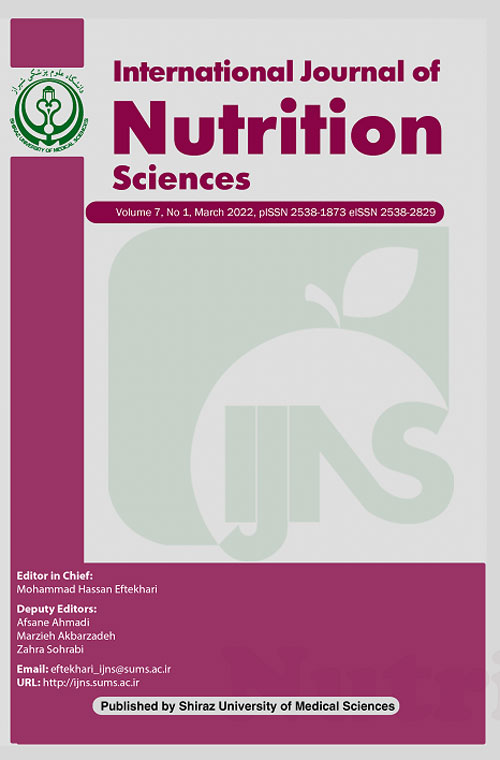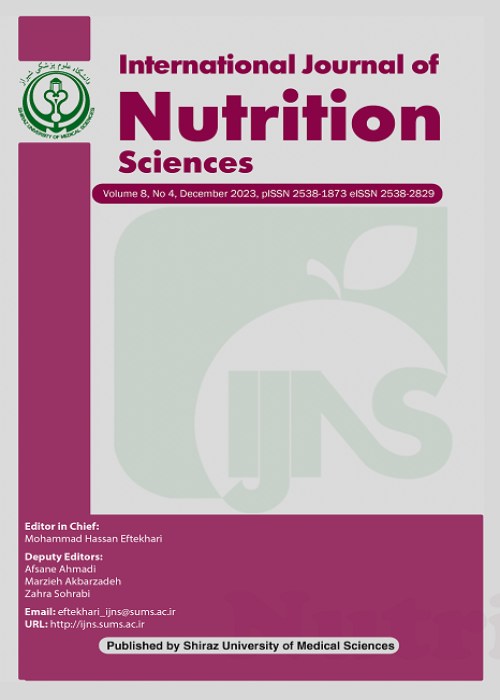فهرست مطالب

International Journal of Nutrition Sciences
Volume:7 Issue: 2, Jun 2022
- تاریخ انتشار: 1401/04/11
- تعداد عناوین: 8
-
-
Pages 65-72
Many human diseases are caused by infection with either viruses or bacteria. The proper functioning of the immune system is essential for the survival of any individual throughout life. The optimal immune response depends on an adequate nutrition and appropriate food pattern to prevent infection. For example, getting enough protein is important for optimal antibody production. Minerals and vitamins are forms of nutrients (called micronutrients) that have the appropriate capacity to support the immune system by providing preventive mediators of infectious diseases to reduce the rate of destruction of cells transported by free radicals or to help the better functioning of T-cells. Reduced intake of micronutrients such as vitamins A, E, C, D, B6, B9, and B12, as well as minerals such as zinc, magnesium, iron, selenium, and copper can decrease resistance toinfections. Therefore, it is necessary to design a review study that looks at the role of micronutrients in preventing infectious diseases.
Keywords: Immune system, infection, Nutrition, Micronutrient -
Pages 73-78
The infant gut undergoes significant developmental phases that are fully dependent upon the colonization with microorganisms, beginning at birth. This colonization of gut microbiota has a powerful impact on host metabolic and immune homoeostasis. Probiotics strains exhibit a wide range of health benefits by modifying the intestinal microbiota and immunity. Lactobacillus reuteri is one of the most extensively studied probiotic strains. It promotes gut health by stimulation of mucosal gut barrier functions, production of antimicrobial substances (such as reuterin and lactic acid) and influencing acquired and innate immune responses. Reuterin produced by L. reuteri is a potent anti-microbial compoundcapable of inhibiting a wide spectrum of pathogenic microorganisms. Apart from antimicrobial metabolite production, L. reuteri creates biofilms that stimulate tumor necrosis factor production by lipopolysaccharide (LPS)- activated monocytoid cells. Interestingly, L. reuteri administration has emerged as a potential therapy for childhood functional gastrointestinal disturbances as these disturbances are associated with gut microbiota perturbations in early life. The current review summarizes the beneficial aspects of the probiotic L. reuteri strain in clinical practice with a special focus on its role in improving gut health and immunity in infants and toddlers.
Keywords: Lactobacillus reuteri, Probiotics, Gut health, Immunomodulation, Infants -
Pages 79-87BackgroundCOVID-19 pandemic has caused disruption to food security in many countries including Nigeria. However, the impact of this on nutritional status of children is unknown. This study was designed to assess the dietary intake and nutritional status of school-aged children in Umudike, Nigeria within the context of COVID-19.MethodsIn this community-based cross-sectional study, the nutrient intake and status of 384 school-children (6-12 years) were studied. Socio-demographic characteristics were obtained using intervieweradministered questionnaire. Dietary intake data were collected using a pretested food frequency questionnaire and multi-pass 24 h dietary recall. The nutrient contents in foods were obtained using Nigerian food composition table. Anthropometrics were measured and wasting, overweight and obesity were defined using standard protocol.ResultsTotally, 70.5% of children consumed starchy tubers frequently. Animal proteins and fruits were infrequently consumed. Diets of 64.0% of children interviewed were characterized by a higher intake of energy above the recommended nutrient intakes (RNIs), while protein intake was below recommendations in 61.4%. Compared to RNIs, majority of the children had inadequate intakes of calcium (70.1%), iron (69.3%) and vitamins C (60.4%) indicating micronutrient inadequacies. Also, 38.3% of children skipped breakfast, while 49.5% replaced lunch with snacks and 14.06% of the children were wasted, and 16.18% were overweight, while 12.36% were obese.ConclusionIt is therefore plausible that overconsumption of nutrientpoor diets and snacks contributed to the poor nutritional status of the children. There is need for intervention programs to address the problem and improve child nutrition in COVID-19 context.Keywords: COVID-19, Dietary intake, Nutritional status, School-children, Nigeria
-
Pages 88-93BackgroundDiet-related information, behaviors, and attitudes are significant factors for building healthier nutritional patterns and preventing diseases.This study aimed to investigate the people’s preference of sources of nutritional information and the most effective sources.MethodsThis descriptive online study was conducted in Shiraz, Iran.Recruitment of the participants was started in February 2020 and ended in March 2020. All 235 male and female participants were enrolled using simple randomization. Demographic variables and nutritional information sources were collected by an online questionnaire. The questionnaire consisted of two parts including the first part containing demographic questions and the mostly used sources of nutritional information according to priority and the second part consisted of 12 questions about the most effective nutritional sources. Continuous data with normal distributionwere expressed in number (%), and qualitative variables were assessed by Chi-Square test.ResultsThe most common and effective sources of nutritional information among the paricipants were social media (87%) and Instagram (41%), respectively. There was a significant difference between age and levelof education in selecting effective sources of information (p≤0.001, p≤0.001, respectively).ConclusionSocial media was recognized as the most effective source of nutritional information. In addition, more comprehensive studies that can survey all the influential factors in this field were suggested.Keywords: Social Media, Nutrition, Information, Source, Iran
-
Pages 94-99BackgroundTotal parenteral nutrition (TPN) is used to maintain the nutritional status of children in surgical wards which is essential not only for patients’ recovery, but also for normal growth and development. Given the high prevalence of TPN in the surgical wards, the present study was designed to investigate the short-term complications of TPN and the factors affecting in children’s medical center, in Tehran, Iran.MethodsIn a retrospective cross-sectional study, all records of patients who underwent TPN in surgery wards of the children’s medical center of Tehran, Iran between 2017 and 2020 were enrolled. Demographic and baseline data including sex, age and also type of surgery, duration of TPN, TPN content, and short-term complications were analyzed.Resultsone hundred and forty-five children including 97 males (66.9%) and 48 females (33.1%) were enrolled. Female patients had a significantly higher rate of central line-associated bloodstream infections (CLABSI, p=0.03). The duration of TPN was significantly correlated with the incidence of glucose disturbances (p=0.012), metabolic acidosis (p=0.05), potassium disturbances (p=0.03), liver disorders (p=0.001), dehydration (p=0.002), and CLABSI (p=0.002). The age of the patientswas also significantly associated with the prevalence of potassium disturbances (p<0.001), liver complications (p<0.001), and positive blood culture (p=0.001). TPN content was not significantly associated with complications.ConclusionLong-term TPN was shown to increase the risks of various metabolic diseases and CLABSI. Monitoring of electrolytes levels, liver function, and other health status aspects is necessary for the patient under prolonged TPN.Keywords: Total parenteral nutrition, TPN, Complications, children, Iran
-
Pages 100-107BackgroundThe steadily increase in prevalence of overweight/obesity coexisted with under-nutrition can pose a major public health problem among adult populations in most of developing countries. In India, the prevalence of overweight/obesity is increasing rapidly, particularly among men. So an attempt was made to study the regional disparities in duel burden of malnutrition among rural men aged 15-54 years in India.MethodsData from fourth round of National Family Health Survey (NFHS-4, 2015-16) of India was used for this study. Totally, 672,1779 men aged 15-54 years were interviewed from rural areas of India. Multinomial logistic regression analysis was used to quantify the results.ResultsA total of 23% of men aged 15-54 years in rural regions of India were underweight and 15% were overweight or obese. The risk of underweight was highest in central regions followed by west and east regions, in men in younger age and among unmarried subjects. Overweight/obesity was more prevalent in southern regions followed by north and west regions, among men in older age, and in married cases. Educational level, wealth index, and access to media were positively associated with overweight/obesity.ConclusionIn India, the prevalence of overweight/obesity was shown to be double among men in rural areas; whereas underweight is still prevalent that denotes to an alarming and necessity for an effective policy and program implementations to address this situation.Keywords: Regional variation, Under-nutrition, Overweight, Obesity, India
-
Pages 109-117BackgroundMany studies have reported the beneficial health properties of Garcinia kola (G. kola) seed from Ivory Coast. This study aimed to investigate the toxicity, anti-hyperlipidemic, and anti-hyperglycemic effect of aqueous extract of G. kola (AEGk) seed in rats subjected to the High Fat and Sucrose Diet (HFSD).MethodsAcute toxicity study was performed according to Organisation for Economic Co-operation and Development (OECD) Guidelines 423. In this study, AEGk was administered starting at 2000 mg/kg and followed by 4000 mg/kg. Rats were observed for toxic signs at 24 h and the next 14 days. For the AEGk effect on hyperlipidemia, hyperglycemia and liver and kidney biochemical markers, animals were divided into five groups. Group I (Control) was fed with a normal diet; Group II, III, IV and V were fed with HFDS and received respectively, 0,9% NaCl, 10 mg/kg statin, and 600 or 1000 mg/kg AEGk daily for four weeks. Finally, histological assessment of liver, kidney and adipose tissue was undertaken.ResultsAEGk at single dose of 4000 mg/kg revealed no lethal effects. Treatment with AEGk significantly decreased hyperlipidemia (p<0.05), hyperglycemia and the relative weight of adipose tissue (p<0.001 for 1000 mg/kg). Histologically, fat deposits in the liver and kidney damage decreased.ConclusionOverall, AEGk was relatively safe in rats at a single dose except for some transient disturbances (4000 mg/kg) and showed some potential in the management of cardiometabolic diseases.Keywords: Garcinia kola, Hyperlipidemia, Hyperglycemia, Obesity, Liver, Rat
-
Pages 118-121
We presented an 18-month old female patient known as failure-to-thrive (FTT) with poor weight gain during the first postpartum weeks. After 20 days of birth, she manifested lethargy, fatigue, fever, and diarrhea and was admitted to the hospital with acute colitis and rectovaginal fistula. She was later fixed for the fistula and underwent upper gastrointestinal (GI) endoscopy, abdominopelvic sonography and colonoscopy and was eventually diagnosed with very-early-onset inflammatory bowel disease (VEO-IBD).
Keywords: Very-early-onset inflammatory bowel disease, Malnutrition, Failure-to-thrive, Dietary management


